Art
An American Art Critic’s 70-Year Love Affair With Rome
|
|
The New York–born critic and photographer Milton Gendel (1918–2018) lived in Rome for the last 70 years of his life, a quiet man observing the international swirl of artists, writers, aristocrats, and socialites of which he was himself a part—not to mention the ordinary hubbub of Roman life. Gendel died in 2018, not long before his 100th birthday. He would always say, of his seven decades in Rome, that he was “just passing through,” but his various homes in the city became a hub for figures including Antonia Fraser and Iris Origo to Princess Margaret and the collector Mimi Pecci Blunt. While personally unobtrusive, he was a shrewd listener, seemed to know everyone, and found his way everywhere. Gendel left behind tens of thousands of photographs and 10 million words of diary entries chronicling the cultural and social scene at the intersection of the American Century and la dolce vita. A collection of Gendel’s words and pictures, excerpted below, will be published tomorrow.

Rome. Monday, November 13, 1967
Lunch at Piazza Campitelli. Walk to St. Peter’s. After two or three years of having the nave encumbered with seats—for the Council—the church looks as it used to do. What balls was taught about the interior. [The art historian Everard M.] Upjohn at Columbia used to say with conviction that the space had been falsified by the decorations. The mosaics and sculptures and the architectural details were out of scale, and thus one had no real idea of the vast proportions of the building. This is not true. The visitors give the scale themselves immediately. The space is measurable, in terms of the familiar classical orders—it is clearly one of the largest such spaces in existence. Comparable—as a question of scale—is the Pantheon. The Upjohns were thinking of another kind of space and comparing it to that of St. Peter’s, to the disadvantage of the latter: the kinds of space developed from the end of the Imperial Roman times to the Gothic period. In other words, spaces created with unmeasurable elements, which give an illusion of incommensurable continuity.
It was a beautiful day, and at 4:00 the basilica was still very light. Beams striking down from the window over the front doors. Small figures of visitors moving along the great concourse that is the nave. I was reminded of Pennsylvania Station. It was wrong to destroy it. In a Communist country, it would not have happened for the same reason that so much was preserved in Italy: poverty.

Rome. Wednesday, December 6, 1967
At 8:00 to Carla Panicali’s. Dinner for the Calders. Very lively. Louisa Calder tangled with me at once on Vietnam, not realizing we were more or less on the same side. But that was partly because she has become so rabidly anti-government that she speaks well of de Gaulle. [Alexander] Calder a great, fumbling, white-haired thing in red shirt and red tie. Almost incomprehensible because he slurs his words since he had a heart attack. Slurred them before, too. But he is swift and piercing in his glances and seems to hear everything from all sides of the table. Horseplay with a datepick in the shape of a woman. Calder making a kind of mobile out of a fork and the pick and a date.


Rome. Wednesday, May 30, 1973
I had a long conversation with [the diarist and biographer] Iris Origo, whom I haven’t seen in a very long time … She spoke about her shyness, how she always felt out of things when she was a girl, especially as she had to change among three different cultures, American, Italian, and English. Bernard Berenson dismayed her once, when she was seventeen, and he hurled a challenging question at her across his salotto, which was full of people. She mustered her courage and answered—something about what she wanted out of life. That’s what I mean, he said with disdain, addressing the others—that is conventional thinking. She spoke about his diaries and his self-dissatisfaction. I said that it was a pity he had been born too soon; he was a generation or two out of line. Nowadays there would be very little conflict over his commercial operations and his scholarship. He didn’t have enough balance to see that he had gotten out of life the most that he was capable of. He was a worldling with dreams of monastic cloistered scholarship.


Rome. Thursday, August 23, 1973
To Carla Panicali’s to give her the transparency from Tom [Hess] for his article on Ad Reinhardt and to hear the story of the pope’s museum of modern art. Monsignor Pasquale Macchi, a polished little fellow, was the man behind the effort. He is a promoter and saw it as a good thing for the Vatican image. He succeeded in getting presents from artists and patrons. For instance, Gianni Agnelli has given a Francis Bacon, worth 150 million lire, and a Marino Marini worth 50. Carla had no plausible explanation as to why Gianni should have been so munificent. In secret, she told me that Macchi had bought some things from her directly—about 50 million lire worth—and she expected him to buy much more. This was not to be known publicly, as the Vatican preferred to play poor-mouth. In fact, at the opening the pope had referred to the generosity of friends of the Vatican who had made the museum possible “senza intaccare le finanze traballanti del Vaticano” [without affecting the shaky finances of the Vatican]. There was a suspicion of general suppressed laughter, said Carla.


Rome. Saturday, February 9, 1974
Josephine [Powell] drove out with me to some junkyards she knew about. The best was a large area off the Via Appia Nuova, on the Raccordo Anulare, to the left. A monumental woman … dominated the yard from a snug furnished hut. Outside was a colossal wrought iron lantern with colored glass—something from a turn-of-the-century theater or department store. I priced a spiral staircase (180,000 lire), a straight iron ladder (50,000), some marble—white—about 25,000 for enough to make a fireplace. Josephine priced a four-wheeled cart of silvery old wood—70,000 lire.
But the prize of the junkyard was a group of toilet fixtures—a vast porcelain bath—oval—and another smaller one, a sink on a pedestal and a neoclassic toilet bowl. The woman owner made an impressed face when I asked the price. Quella è roba buona … la vasca più grande era del Duce [That’s good stuff … the bigger tub was Mussolini’s] …
On the way back to Rome, we stopped at a stone yard to price slate and peperino. A man with a mustache gave me the various prices—a beautiful dark pietra serena came to 9,000 lire a square meter; green marble, 16,000 … He also had rosa di Francia, a pretty pink marble, and many kinds of travertine. He asked me whether I was an artist, [and] when he heard that I was a giornalista, he said that he hoped I did not pay attention to the clothes a person wore—che non bada ai panni—and got me into his field house, where he showed me a book with a reproduction of a confused surrealist painting he had done. His name is Pasqua Pierini, and he was eager to have a conversation about art. I was not and tried to show that I was really an undereducated American and wasn’t up to a metaphysical conversation.
He became more animated, though, and pronounced in a D’Annuzian way on the burning fires of creativity.


Rome. [Undated] 1980
Alex and Tatiana Liberman expansive at the Rally Room of the Grand Hotel. The fashion shows were over, and you could breathe again, said Alex. Why, yesterday this room was packed with fashion people, and now they’ve all gone. I ate gamberetti and spigola and raspberries. Delicious food. Alex sailed into Balthus. He was a phony painter, just as he was a phony aristocrat and phony everything. Tatiana liked his work but found it limited. Why was it so “frozen”? I cited Chardin, Poussin, Piero, Vermeer, putting Balthus in company that’s really a bit too good for him. Alex declared that he couldn’t stand the “literary” character of the work. He liked only abstract art. He sounded like an old manual of the old avant garde …
And what explained the grandiosity of Roman buildings? They had been to see the Palazzo Spada, at my suggestion. It was power, wasn’t it? Imperial power. But that collection of paintings was pathetic, said Alex. All second-rate. Rome was second-rate in its art, wasn’t it? There wasn’t a Louvre. I composed them a Louvre by imagining the Barberini and Corsini collections thrown together with the addition of the Galleria Borghese and the Doria Pamphilj and the Vatican and the Sistine Chapel and Raphael’s Stanze.
They didn’t seem to get the point, and I felt that they would go away repeating that art in Rome was mediocre. Despite my citation of the Masolino and Pinturicchio wall paintings and the Rubenses and other notable works in the churches. Caravaggio.


Rome. Thursday, March 17, 1983
The cleaned Michelangelo frescoes in the Sistine Chapel are spectacular. What a transformation. The sixteenth-century palette becoming visible again. Basis for all the later Mannerist color. And the high relief of the figures and of the architectural elements when they are not flattened by accumulated grime.
Leo [Steinberg, an art critic,] spotted [Fabrizio] Mancinelli, the curator of Renaissance art, who was standing with [the art historians] John Shearman and Kathleen Weil-Garris observing the display of Raphael tapestries. Shearman had figured out the sequence of the tapestries that were made for Leo X and were full of Medici iconography and found where they were meant to go. He said, humorously triumphant, They fit!
A guard with a fierce manner but a twinkling expression was routing well-groomed elderly American ladies who were flashing away at the walls. Using flashes is not allowed in the chapel. Leo was very interesting on The Last Judgment. Michelangelo had rebuilt the wall so that it sloped in 30 cm. from the top to the bottom. Vasari, ridiculously pragmatic, according to Leo, said that this was done so that the dust wouldn’t gather on the surface of the wall. But it was to emphasize the invasion of the chapel’s space by The Last Judgment. The Church Triumphant replaces the Church Militant, and Christ himself takes the place of the popes. Hence there was no coat of arms of Paul III to replace the one of Sixtus IV corresponding to the one on the opposite wall that had been there. Michelangelo had progressively stepped up the scale of his figures toward the end wall. And the great moldings, for instance defining the corner lunettes, had been narrowed to the maximum.
And look at the cross that the stocky figure is planting—where is he setting it? On the cornice itself. That is Simon of Cyrene, according to Leo, and the painting is the first example in art history of the painted invading the real space.
This article was adapted from the book Just Passing Through—A Seven-Decade Roman Holiday: The Diaries and Photographs of Milton Gendel, edited by Cullen Murphy.
When you buy a book using a link on this page, we receive a commission. Thank you for supporting The Atlantic.





Art
The Venice Biennale and the Art of Turning Backward – The New York Times


There is a sour tendency in cultural politics today — a growing gap between speaking about the world and acting in it.
In the domain of rhetoric, everyone has grown gifted at pulling back the curtain. An elegant museum gallery is actually a record of imperial violence; a symphony orchestra is a site of elitism and exploitation: these critiques we can now deliver without trying. But when it comes to making anything new, we are gripped by near-total inertia. We are losing faith with so many institutions of culture and society — the museum, the market, and, especially this week, the university — but cannot imagine an exit from them. We throw bricks with abandon, we lay them with difficulty, if at all. We engage in perpetual protest, but seem unable to channel it into anything concrete.
So we spin around. We circle. And, maybe, we start going backward.
I’ve just spent a week tramping across Venice, a city of more than 250 churches, and where did I encounter the most doctrinaire catechism? It was in the galleries of the 2024 Venice Biennale, still the world’s principal appointment to discover new art, whose current edition is at best a missed opportunity, and at worst something like a tragedy.
It’s often preachy, but that’s not its biggest problem. The real problem is how it tokenizes, essentializes, minimizes and pigeonholes talented artists — and there are many here, among more than 300 participants — who have had their work sanded down to slogans and lessons so clear they could fit in a curator’s screenshot. This is a Biennale that speaks the language of assurance, but is actually soaked in anxiety, and too often resorts, as the Nigerian author Wole Soyinka deplored in a poem, to “cast the sanctimonious stone / And leave frail beauty shredded in the square / Of public shame.”
This year’s Biennale opened last week under an ominous star. The Venetian megashow consists of a central exhibition, spanning two locations, as well as around 90 independent pavilions organized by individual nations. One of these nations is Israel, and in the weeks before the vernissage an activist group calling itself the “Art Not Genocide Alliance” had petitioned the show’s organizers to exclude Israel from participating. The Biennale refused; a smaller appeal against the pavilion of Iran also went nowhere. (As for Russia, it remains nation non grata for the second Biennale in a row.) With disagreements over the war in Gaza spilling into cultural institutions across the continent — they’d already sunk Documenta, the German exhibition that is Venice’s only rival for attendance and prestige — the promise of a major controversy seemed to hang over the Giardini della Biennale.
As it happened, the artist and curator of Israel’s pavilion surprised the preview audience by closing their own show, and posted a sign at the entrance declaring it would stay shut until “a cease-fire and hostage release agreement is reached.” A small protest took place anyway (“No Death in Venice” was one slogan), but the controversy had only a tiny impact on the Prosecco-soaked Venetian carnival that is opening week. Right next door, at the U.S. Pavilion, twice as many visitors were waiting to get inside as were protesting.
One could strain to read the Israeli withdrawal productively, as part of a century-long tradition of empty, vacated or closed exhibitions by artists such as Rirkrit Tiravanija, Graciela Carnevale, and all the way back to Marcel Duchamp. Probably it was the only possible response to an untenable situation. Either way, the Israel pavilion encapsulated in miniature a larger dilemma and deficiency, in Venice and in culture more broadly: a thoroughgoing inability — even Foucault did not go this far! — to think about art, or indeed life, as anything other than a reflection of political, social or economic power.
That is certainly the agenda of the central exhibition, organized by the Brazilian museum director Adriano Pedrosa. I’d cheered when he was appointed curator of this year’s edition. At the São Paulo Museum of Art, one of Latin America’s boldest cultural institutions, Pedrosa had masterminded a cycle of centuries-spanning exhibitions that reframed Brazilian art as a crucible of African, Indigenous, European and pan-American history. His nomination came a few weeks after Giorgia Meloni became Italy’s first far-right prime minister since World War II. And Pedrosa — who had successfully steered his museum through Brazil’s own far-right presidency of 2018-22 — promised a show of cosmopolitanism and variety, as expressed in a title, “Foreigners Everywhere,” that seemed like a moderate anti-Meloni dig.
But what Pedrosa has actually brought to Venice is a closed, controlled, and at times belittling showcase, which smooths out all the distinctions and contradictions of a global commons. The show is remarkably placid, especially in the Giardini. There are large doses of figurative painting and (as customary these days) weaving and tapestry arranged in polite, symmetrical arrays. There is art of great beauty and power, such as three cosmological panoramas by the self-taught Amazonian painter Santiago Yahuarcani, and also far less sophisticated work celebrated by the curator in the exact same way.
In the brutal rounding-down arithmetic of the 2024 Venice Biennale, to be a straniero — a “foreigner” or “stranger,” applied equally to graduates of the world’s most prestigious M.F.A. programs and the mentally ill — implies moral credibility, and moral credibility equals artistic importance. Hence Pedrosa’s inclusion of L.G.B.T.Q. people as “foreigners,” as if gender or sexuality were proof of progressive bona fides. (Gay men have led far-right parties in the Netherlands and Austria; over at Venice’s Peggy Guggenheim Collection is a wonderfully pervy show of the polymathic Frenchman Jean Cocteau, who praised Nazis while drawing sailors without their bell-bottoms.)
Even more bizarre is the designation of the Indigenous peoples of Brazil and Mexico, of Australia and New Zealand, as “foreigners”; surely they should be the one class of people exempt from such estrangement. In some galleries, categories and classifications take precedence over formal sophistication to a derogatory degree. The Pakistan-born artist Salman Toor, who paints ambiguous scenes of queer New York with real acuity and invention, is shown alongside simplistic queer-and-trans-friendly street art from an Indian NGO “spreading positivity and hope to their communities.”
Over and over, the human complexity of artists gets upstaged by their designation as group members, and art itself gets reduced to a symptom or a triviality. I felt that particularly in three large, shocking galleries in the central pavilion of the Giardini, packed tight with more than 100 paintings and sculptures made in Asia, Africa, Latin America and the Middle East between 1915 and 1990. These constitute the bulk of what Pedrosa calls the show’s nucleo storico, its historical core, and this was the part of the Biennale I’d looked forward to most. It had promised to demonstrate that the world outside the North Atlantic has a history of modern art far richer than our leading museums have shown us.
Indeed it does. But you won’t learn that here, where paintings of wildly different importance and quality have been shoved together with almost no historical documentation, cultural context, or even visual delight. It flushes away distinctions between free and unfree regimes or between capitalist and socialist societies, or between those who joined an international avant-garde and those who saw art as a nationalist calling. True pioneers, such as the immense Brazilian innovator Tarsila do Amaral, are equated with orthodox or traditionalist portraitists. More ambitious exhibitions — notably the giant “Postwar,” staged in Munich in 2016-17 — used critical juxtaposition and historical documentation to show how and why an Asian modernism, or an African modernism, looked the way it did. Here in Venice, Pedrosa treats paintings from all over as just so many postage stamps, pasted down with little visual acuity, celebrated merely for their rarity to an implied “Western” viewer.
You thought we were all equals? Here you have the logic of the old-style ethnological museum, transposed from the colonial exposition to the Google Images results page. S.H. Raza of India, Saloua Raouda Choucair of Lebanon, the Cuban American Carmen Herrera, and also painters who were new to me, got reduced to so much Global South wallpaper, and were photographed by visitors accordingly. All of which shows that it’s far too easy to speak art’s exculpatory language, to invoke “opacity” or “fugitivity” or whatever today’s decolonial shibboleth may be. But by othering some 95 percent of humanity — by designating just about everyone on earth as “foreigners,” and affixing categories onto them with sticky-backed labels — what you really do is exactly what those dreadful Europeans did before you: you exoticize.
And yet, for all that, there is so much I liked in this year’s Biennale! From the central exhibition I am still thinking about a monumental installation of unfired coils of clay by Anna Maria Maiolino, a winner of the Golden Lion for Lifetime Achievement, that recasts serial production as something intimate, irregular, even anatomical. Karimah Ashadu, who won the Silver Lion for her high-speed film of young men bombing across Lagos on banned motorbikes, gave the economic intensity of megacity life a vigorous visual language. There are the stark, speechless paintings from the 1970s of Romany Eveleigh, whose thousands of scratched little O’s turn writing into an unsemantic howl. There are Yuko Mohri’s mischievously articulated assemblages of found objects, plastic sheeting and fresh fruit, in the Japanese Pavilion, and Precious Okoyomon’s Gesamtkunstwerk of soil, speakers and motion sensors, in the Nigerian Pavilion.
Beyond the Biennale, Christoph Büchel’s frenzied exhibition at the Fondazione Prada assembles mountains of junk and jewels into an impertinent exposé of wealth and debt, colonialism and collecting. In the Palazzo Contarini Polignac, a hazily elegant video by the Odesa-born artist Nikolay Karabinovych reinscribes the Ukrainian landscape as a crossroads of languages, religions and histories. Above all there is Pierre Huyghe, at the Punta della Dogana, who fuses human intelligence and artificial intelligence into the rarest thing of all: an image we have never seen before.
What all these artists have in common is some creative surplus that cannot be exploited — not for a nation’s image, not for a curator’s thesis, not for a collector’s vanity. Rather than the sudsy “politics” of advocacy, they profess that art’s true political value lies in how it exceeds rhetorical function or financial value, and thereby points to human freedom. They are the ones who offered me at least a glimpse of what an equitable global cultural assembly could be: an “anti-museum,” in the phrase of the Cameroonian philosopher Achille Mbembe, where “the exhibiting of subjugated or humiliated humanities” at last becomes a venue where everyone gets to be more than a representative.
I still, unfashionably, keep faith with Mbembe’s dream institution, and the artists here who would have their place in it. But we won’t build it with buzzwords alone, and if anyone had actually been paying attention to the political discourse in this part of the world in a time of war, they would have realized that two can play this game. “An essentially emancipatory, anticolonial movement against unipolar hegemony is taking shape in the most diverse countries and societies” — did someone in the 2024 Venice Biennale say that? No, it was Vladimir Putin.
Art
Turner Prize shortlist includes art showcasing Scottish Sikh community
|
|
A Scottish artist who uses cars, worship bells and Irn-Bru in her work is among the nominees for this year’s Turner Prize.
Glasgow-born Jasleen Kaur’s work reflects her life growing up in the city’s Sikh community.
She is up for the prestigious art award, now in its 40th year, alongside Pio Abad, Claudette Johnson and Delaine Le Bas.
Turner Prize jury chairman Alex Farquharson described it as a “fantastic shortlist of artists”
Works by the nominated artists will go on show at London’s Tate Britain gallery from 25 September.
They will receive £10,000 each, while the winner, to be announced on 3 December, will get £25,000.
In a statement, Farquharson said: “All four make work that is full of life.
“They show how contemporary art can fascinate, surprise and move us, and how it can speak powerfully of complex identities and memories, often through the subtlest of details.
“In the Turner Prize’s 40th year, this shortlist proves that British artistic talent is as rich and vibrant as ever.”
The shortlisted artists are:
Pio Abad
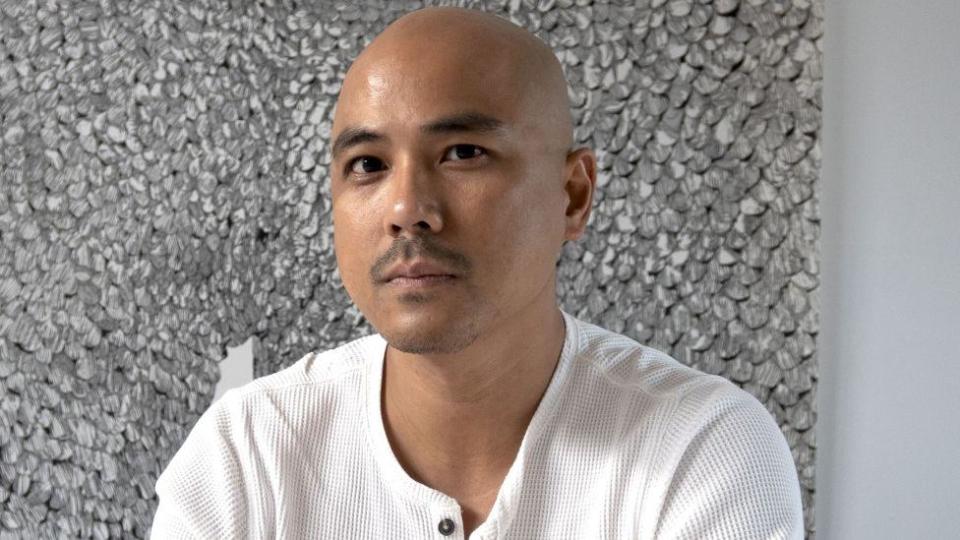

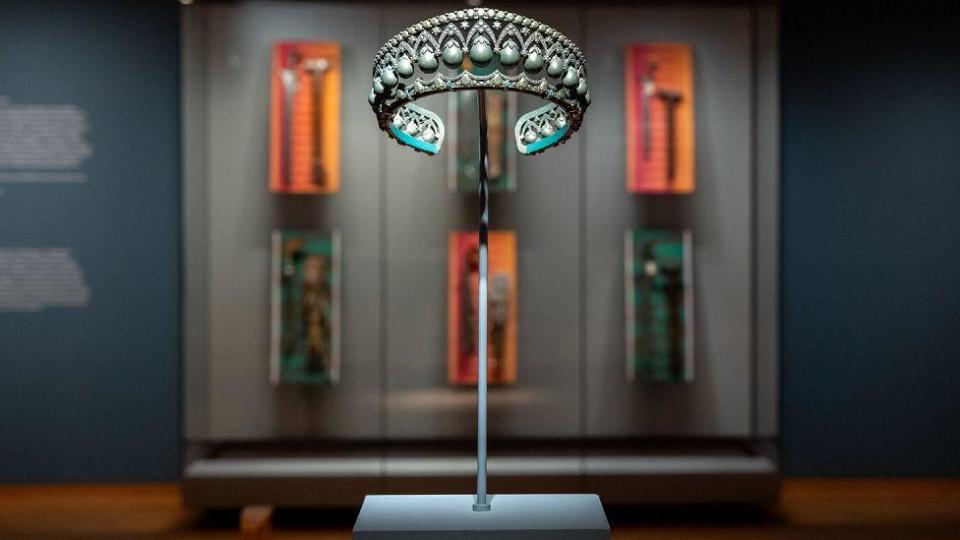

Manila-born Abad’s solo exhibition To Those Sitting in Darkness at the Ashmolean Museum in Oxford included drawings, etchings and sculptures that combined to “ask questions of museums”, according to the jury.
The 40-year-old, who works in London, reflects on colonial history and growing up in the Philippines, where his parents struggled against authoritarianism.
The title of his exhibit is a nod to Mark Twain’s 1901 essay To the Person Sitting In Darkness, which hit out at imperialism.
Jasleen Kaur


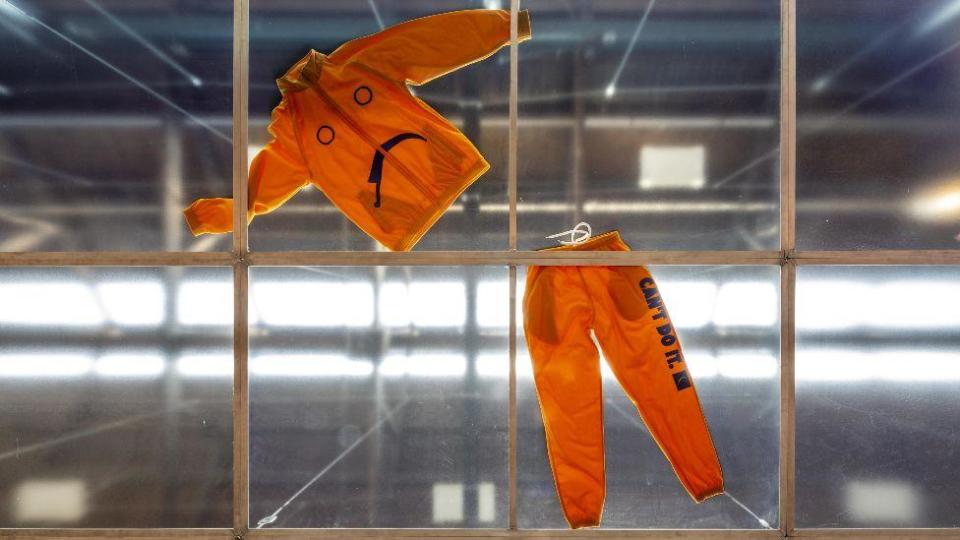

Kaur is on the list for Alter Altar at Tramway, Glasgow, which included family photos, an Axminster carpet, a classic Ford Escort covered in a giant doily, Irn-Bru and kinetic handbells.
The 37-year-old, who lives in London, had previously showcased her work at the Victoria and Albert Museum by looking at popular Indian cinema.
Delaine Le Bas


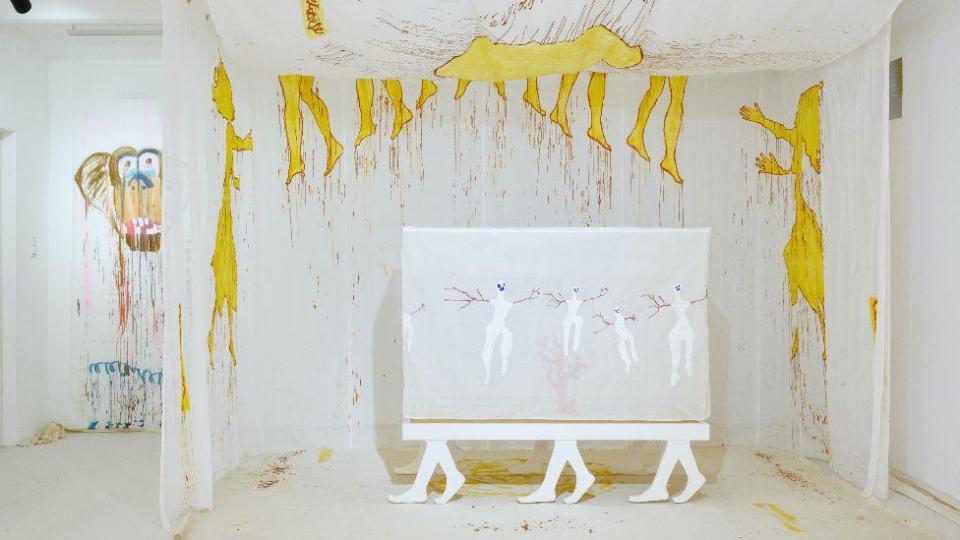

Worthing-born Le Bas is nominated for an exhibition titled Incipit Vita Nova. Here Begins The New Life/A New Life Is Beginning. Staged at the Secession art institute in Vienna, Austria, it saw painted fabrics hung, with theatrical costumes and sculptures also part of the exhibit.
The 58-year-old artist was inspired by the death of her grandmother and the history of the Roma people.
The jury said they “were impressed by the energy and immediacy present in this exhibition, and its powerful expression of making art in a time of chaos”.
Claudette Johnson


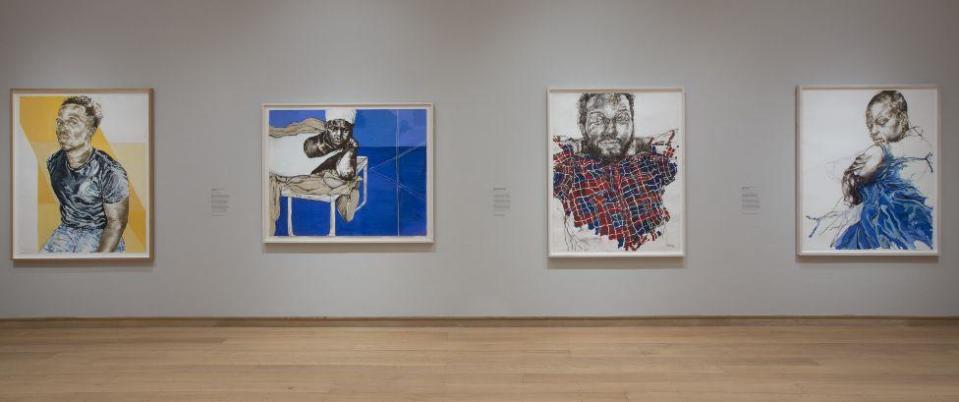

Manchester-born Johnson has been given the nod for her solo exhibition Presence at the Courtauld Gallery in London, and Drawn Out at Ortuzar Projects, New York.
She uses portraits of black women and men in a combination of pastels, gouache and watercolour, and was praised by the judges for her “sensitive and dramatic use of line, colour, space and scale to express empathy and intimacy with her subjects”.
Johnson, 65, was appointed an MBE in 2022 after being named on the New Year Honours list for her services to the arts.





Art
Turner Prize: Shortlisted artist showcases Scottish Sikh community
|
|
Turner Prize shortlist includes art showcasing Scottish Sikh community


A Scottish artist who uses cars, worship bells and Irn-Bru in her work is among the nominees for this year’s Turner Prize.
Glasgow-born Jasleen Kaur’s work reflects her life growing up in the city’s Sikh community.
She is up for the prestigious art award, now in its 40th year, alongside Pio Abad, Claudette Johnson and Delaine Le Bas.
Turner Prize jury chairman Alex Farquharson described it as a “fantastic shortlist of artists”
Works by the nominated artists will go on show at London’s Tate Britain gallery from 25 September.
They will receive £10,000 each, while the winner, to be announced on 3 December, will get £25,000.
In a statement, Farquharson said: “All four make work that is full of life.
“They show how contemporary art can fascinate, surprise and move us, and how it can speak powerfully of complex identities and memories, often through the subtlest of details.
“In the Turner Prize’s 40th year, this shortlist proves that British artistic talent is as rich and vibrant as ever.”
The shortlisted artists are:
Pio Abad
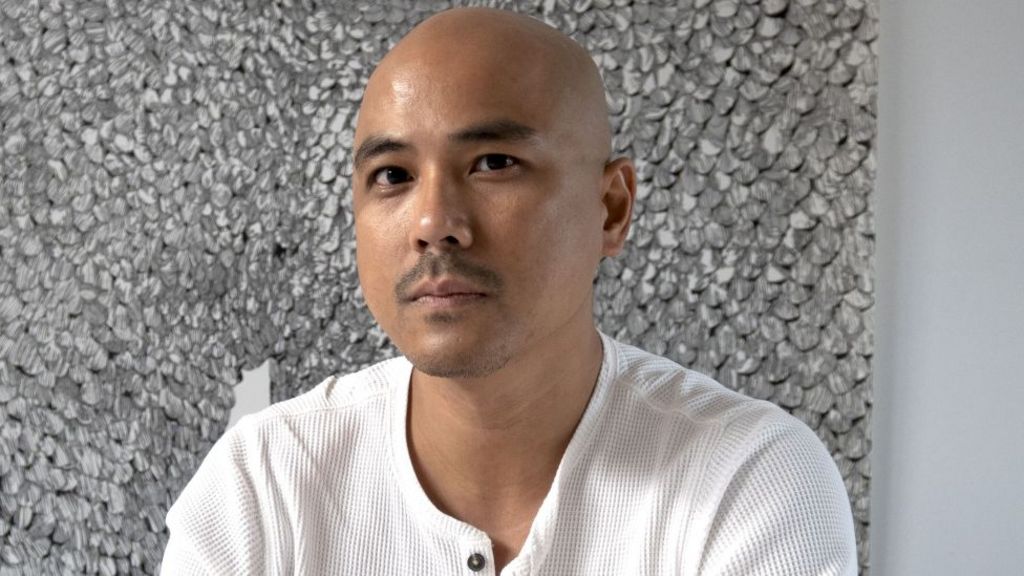

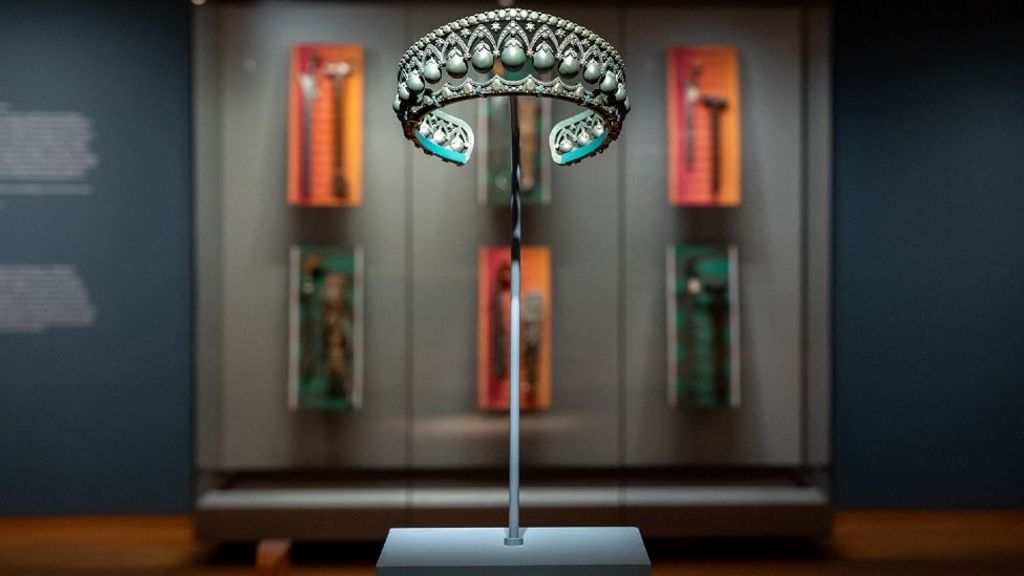

Manila-born Abad’s solo exhibition To Those Sitting in Darkness at the Ashmolean Museum in Oxford included drawings, etchings and sculptures that combined to “ask questions of museums”, according to the jury.
The 40-year-old, who works in London, reflects on colonial history and growing up in the Philippines, where his parents struggled against authoritarianism.
The title of his exhibit is a nod to Mark Twain’s 1901 essay To the Person Sitting In Darkness, which hit out at imperialism.
Jasleen Kaur


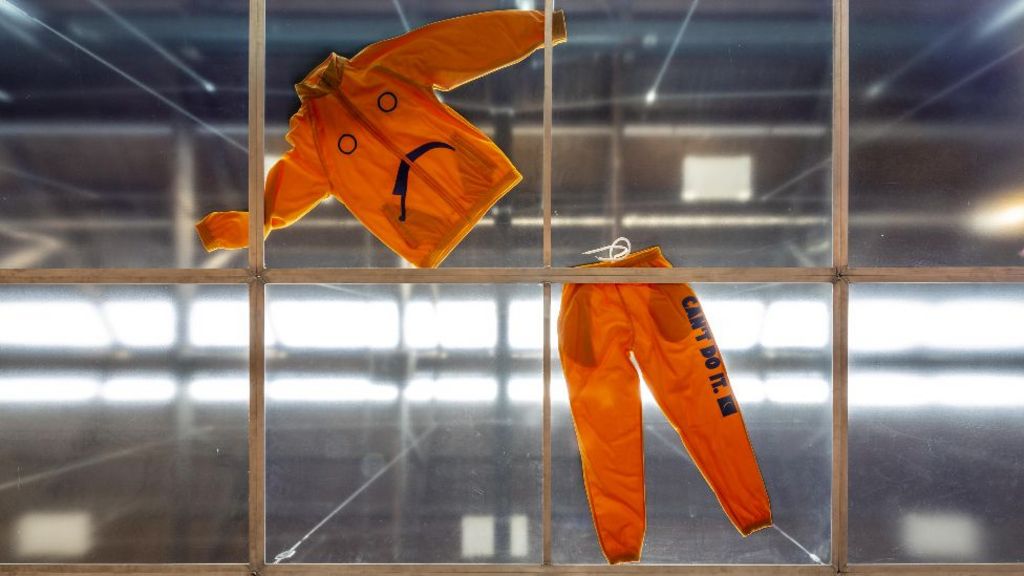

Kaur is on the list for Alter Altar at Tramway, Glasgow, which included family photos, an Axminster carpet, a classic Ford Escort covered in a giant doily, Irn-Bru and kinetic handbells.
The 37-year-old, who lives in London, had previously showcased her work at the Victoria and Albert Museum by looking at popular Indian cinema.
Delaine Le Bas
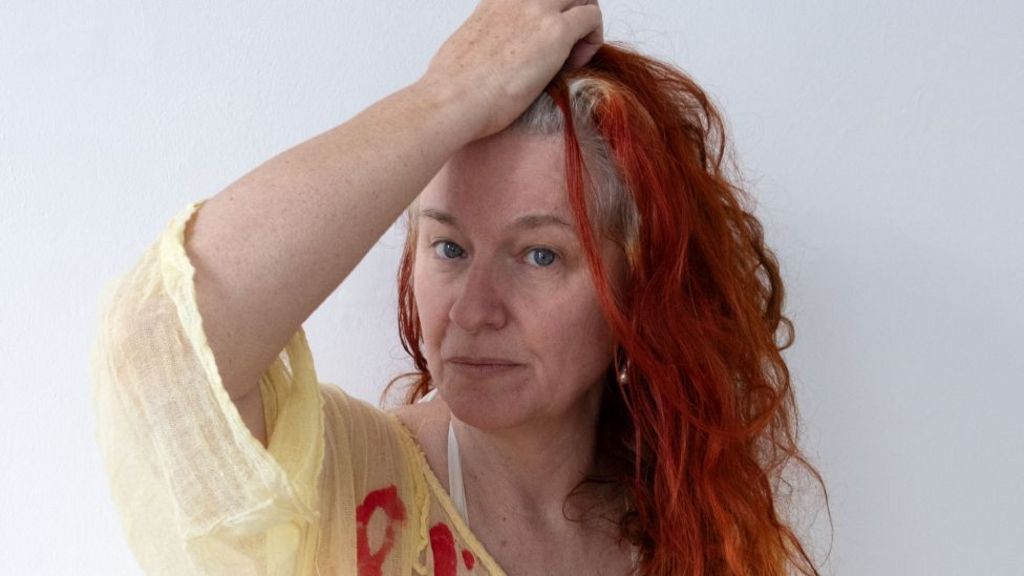

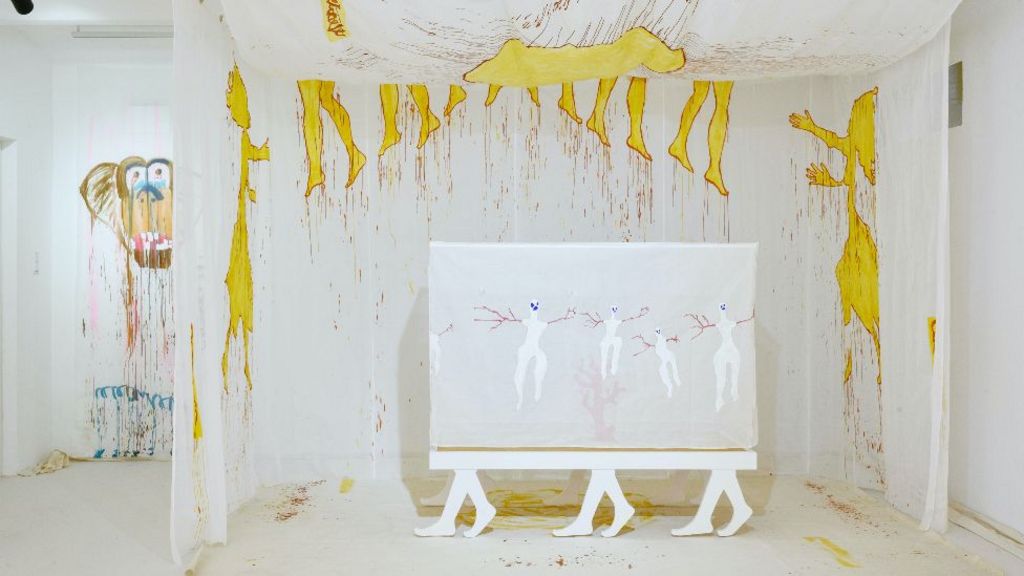

Worthing-born Le Bas is nominated for an exhibition titled Incipit Vita Nova. Here Begins The New Life/A New Life Is Beginning. Staged at the Secession art institute in Vienna, Austria, it saw painted fabrics hung, with theatrical costumes and sculptures also part of the exhibit.
The 58-year-old artist was inspired by the death of her grandmother and the history of the Roma people.
The jury said they “were impressed by the energy and immediacy present in this exhibition, and its powerful expression of making art in a time of chaos”.
Claudette Johnson
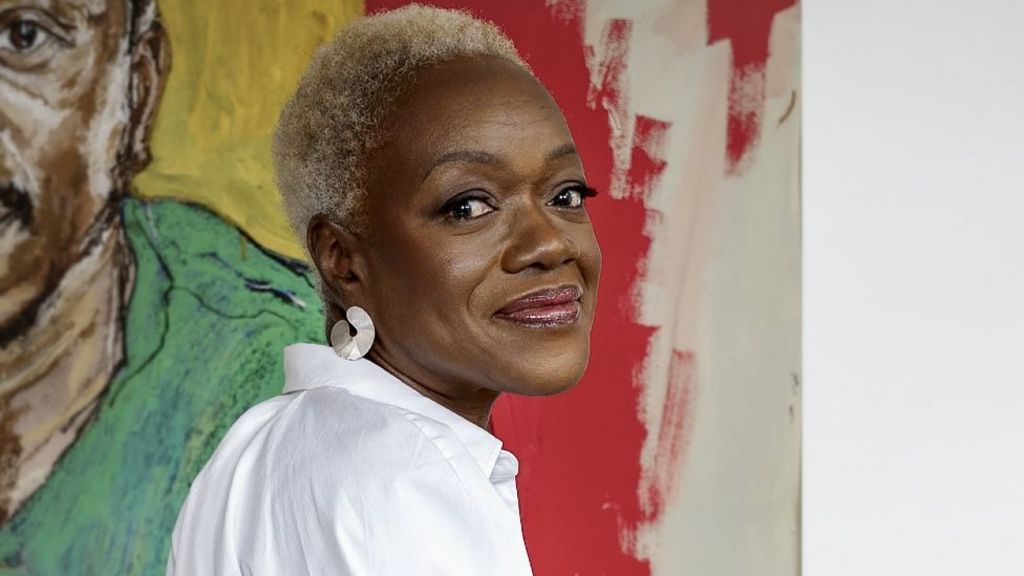

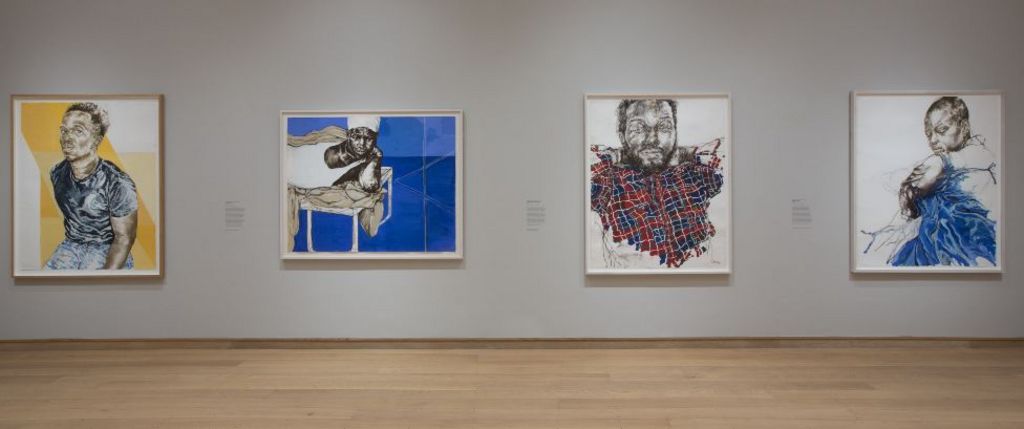

Manchester-born Johnson has been given the nod for her solo exhibition Presence at the Courtauld Gallery in London, and Drawn Out at Ortuzar Projects, New York.
She uses portraits of black women and men in a combination of pastels, gouache and watercolour, and was praised by the judges for her “sensitive and dramatic use of line, colour, space and scale to express empathy and intimacy with her subjects”.
Johnson, 65, was appointed an MBE in 2022 after being named on the New Year Honours list for her services to the arts.





-
News21 hours ago
Amid concerns over ‘collateral damage’ Trudeau, Freeland defend capital gains tax change
-
Art18 hours ago
The unmissable events taking place during London’s Digital Art Week
-



 Politics22 hours ago
Politics22 hours agoHow Michael Cohen and Trump went from friends to foes
-



 Real eState23 hours ago
Real eState23 hours agoBlending Function and Style: The Best Garage Door Designs for Contemporary Homes
-
Science24 hours ago
NASA hears from Voyager 1, the most distant spacecraft from Earth, after months of quiet
-
Media24 hours ago
Vaughn Palmer: B.C. premier gives social media giants another chance
-
News22 hours ago
U.K. tabloids abuzz with Canadian’s ‘Loch Ness monster’ photo
-
Health23 hours ago
Interior Health delivers nearly 800K immunization doses in 2023




